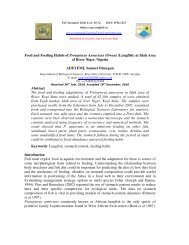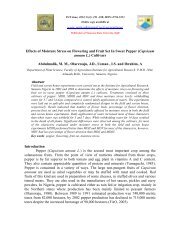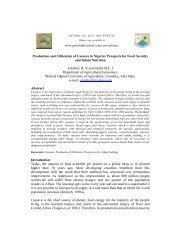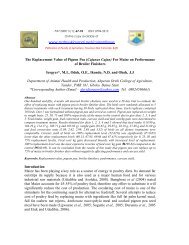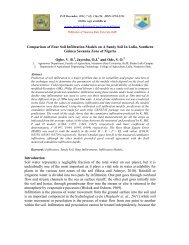Complementary Use of Cow Dung and Mineral Fertilizer: Effect On ...
Complementary Use of Cow Dung and Mineral Fertilizer: Effect On ...
Complementary Use of Cow Dung and Mineral Fertilizer: Effect On ...
Create successful ePaper yourself
Turn your PDF publications into a flip-book with our unique Google optimized e-Paper software.
PAT June 2011; 7 (1): 36-48 ISSN: 0794-5213<strong>On</strong>line copy available atwww.patnsukjournal.net/currentissuePublication <strong>of</strong> Nasarawa State University, Keffi<strong>Complementary</strong> <strong>Use</strong> <strong>of</strong> <strong>Cow</strong> <strong>Dung</strong> <strong>and</strong> <strong>Mineral</strong> <strong>Fertilizer</strong>: <strong>Effect</strong> <strong>On</strong> SoilProperties, Growth, Nutrient Uptake And Yield <strong>of</strong> Sweet Potato (Ipomea batatas)Asawalam, D. O <strong>and</strong> <strong>On</strong>wudike, S. U.Department <strong>of</strong> Soil Science <strong>and</strong> MeteorologyMichael Okpara University <strong>of</strong> Agriculture, Umudike,PMB 7267, Umuahia, Abia State, Nigeriaasawaldo@yahoo.comAbstractThis study evaluated the effect <strong>of</strong> cow dung <strong>and</strong> mineral fertilizer (NPK 15 -15 -15) on soilproperties, growth, nutrient uptake <strong>and</strong> yield <strong>of</strong> sweet potato (Ipomoea batatas) at twolocations (Uturu <strong>and</strong> Umudike) in southeastern Nigeria. The experiment was a r<strong>and</strong>omizedcomplete block design (RCBD) with four replicates. The treatments consisted <strong>of</strong> 3.7 t/ha cowdung, 400 kg/ha NPK fertilizer, 1.9 t/ha cow dung + 200 kg/ha NPK fertilizer, 0.9 t/ha cowdung + 300 kg/ha NPK fertilizer, 2.8 t/ha cow dung + 100 kg NPK fertilizer <strong>and</strong> a control.Combined application <strong>of</strong> cow dung <strong>and</strong> NPK fertilizer significantly (P < 0.05) increasedorganic matter, available P, exchangeable K <strong>and</strong> <strong>Effect</strong>ive Cation Exchange Capacitycompared to the control in both locations. Uptake <strong>of</strong> N, K, Ca <strong>and</strong> Mg were higher withtreatments in which cow dung was combined with NPK fertilizer compared to the control atboth locations. Also, combined application <strong>of</strong> cow dung <strong>and</strong> NPK fertilizer significantly (P
PAT 2011;7 (1): 36-48 ISSN: 0794-5213; Asawalam <strong>and</strong> <strong>On</strong>wudike, <strong>Complementary</strong> <strong>Use</strong> <strong>of</strong> <strong>Cow</strong> <strong>Dung</strong>....... 37The objectives <strong>of</strong> this study therefore, were to: (a) determine the effect <strong>of</strong> cow dung <strong>and</strong>NPK fertilizer on soil properties, <strong>and</strong> (b) determine the influence <strong>of</strong> varying proportions<strong>of</strong> NPK fertilizer <strong>and</strong> cow dung on growth, nutrient uptake <strong>and</strong> yield <strong>of</strong> sweet potato.Materials <strong>and</strong> methodsThe study was conducted at two locations, namely Umudike (Long 7 o 32 / E <strong>and</strong>Lat 5 o 29 / N) <strong>and</strong> Uturu (Long 7 o 20 / E <strong>and</strong> Lat 5o 45 / N), both in Abia State,Southeastern Nigeria. Soils <strong>of</strong> the experimental fields are s<strong>and</strong>y loam in texture,strongly acid in reaction (pH 4.82 – 4.93), medium in organic matter content (2.10 –2.29 %) <strong>and</strong> low in nitrogen <strong>and</strong> potassium contents but marginal in availablephosphorus (Table 1). The experiment was a r<strong>and</strong>omized complete block design(RCBD) with four replicates. The treatments consisted <strong>of</strong> 3.7 t/ha cow dung (T1), 400kg/ha NPK fertilizer (T2), 1.9 t/ha cow dung + 200 kg/ha NPK fertilizer (T3), 0.9 t/hacow dung + 300 kg/ha NPK fertilizer (T4), 2.8 t/ha cow dung + 100 kg NPK fertilizer(T5) <strong>and</strong> a control (no manure <strong>and</strong> no fertilizer) (T6).L<strong>and</strong> preparation, including slashing, ploughing <strong>and</strong> harrowing were carried outbetween May to June 2004. The field was marked out into plots <strong>of</strong> 5 m x 5 m separatedby 1 m alley. Before the treatments were applied, a composite soil sample <strong>of</strong> one augerborings (0 – 30 cm depth) per plot was collected at each location. At the end <strong>of</strong> thestudy, a soil sample from each <strong>of</strong> the experimental plots was also collected to the samedepth. The samples were air-dried, ground <strong>and</strong> passed through 2mm-mesh sieve <strong>and</strong>used for laboratory analysis. <strong>Cow</strong> dung obtained from cattle market at Okigwe, was airdried,weighed <strong>and</strong> appropriate quantities applied on plot by broadcasting <strong>and</strong> workedinto the soil with h<strong>and</strong> hoe. The composition <strong>of</strong> the cow dung is shown in table 2. Sweetpotato vines (variety TIS 87/0087), obtained from National Root Crops ResearchInstitute, Umudike was cut into 20 cm length, <strong>and</strong> planted at a spacing <strong>of</strong> 60 cm x 90cm on flat, giving a plant population <strong>of</strong> 19,200 plants /ha. Sweet potato vines wereplanted two weeks after cow dung incorporation at an angle <strong>of</strong> 45 o . <strong>Mineral</strong> fertilizerwas applied three weeks after planting. Hoe weeding was carried out at 5 <strong>and</strong> 8 weeksafter planting. In each experimental plot, five plants were tagged for measurement <strong>of</strong>number <strong>of</strong> leaves, leaf area, number <strong>of</strong> branches <strong>and</strong> length <strong>of</strong> vines on weekly basesfrom 3 – 13 weeks after planting. Vine length was measured using meter rule. Leaf areawas calculated by using the formula adopted by Asiegbu (1991):A = 0.56 x P x 6.20 .Where A = leaf area <strong>and</strong> P = length x breath. 0.56 <strong>and</strong> 6.20 areboth constants, which account for the spaces created due to irregular shape <strong>of</strong> sweetpotato leaves.At eight weeks after planting, vines <strong>and</strong> leaves <strong>of</strong> two plants per plot wereharvested, oven dried at 65 o C, weighed to determine dry matter, ground in a hammer
PAT 2011;7 (1): 36-48 ISSN: 0794-5213; Asawalam <strong>and</strong> <strong>On</strong>wudike, <strong>Complementary</strong> <strong>Use</strong> <strong>of</strong> <strong>Cow</strong> <strong>Dung</strong>....... 38mill <strong>and</strong> analyzed for nutrient concentrations. At 19 th week after planting, when theleaves have turned yellow, the plants were harvested <strong>and</strong> tuber weights were recorded.Soil samples collected were analyzed for particle size distribution by hydrometermethod (Gee <strong>and</strong> Bauder 1996) using sodium hexametaphosphate as dispersant. Soil pHwas determined in water <strong>and</strong> IN KCl at soil to liquid ratio <strong>of</strong> 1:2.5 using a combinedelectrode pH meter (Thomas 1996). Total nitrogen was determined by semi- microkjeldahl method (Bremner 1996) using selenium tables as catalyst. Organic carbon wasdetermined by chromic acid wet oxidation method <strong>of</strong> Nelson <strong>and</strong> Sommers (1996)while organic matter was determined by multiplying percentage organic carbon by1.724. Available phosphorus was extracted by Bray No 1 method, <strong>and</strong> determined bythe molybdenum blue method (Kuo, 1996). Exchangeable bases were determined by 1Nneutral NH 4 OAC saturation method <strong>of</strong> Grant (1982), exchangeable acidity by themethod <strong>of</strong> Mclean (1965). <strong>Effect</strong>ive cation exchange capacity was determined bysummation <strong>of</strong> total exchangeable bases <strong>and</strong> exchangeable acidity. Nutrient uptake bysweet potato plant was analyzed by dry ashing methods. Sweet potato plant tissues weredried at 65 o C for 72 hours, ground with milling machine <strong>and</strong> subjected to ashing usingporcelain crucible. The ashes were dissolved in 5ml <strong>of</strong> 20% HCl. The solution obtainedwas used for plant nutrient uptake determination.Statistical AnalyisisData obtained were subjected to analysis <strong>of</strong> variance (ANOVA) procedure <strong>of</strong>Statistical Analysis System (SAS, 1989) <strong>and</strong> significant means were separated usingst<strong>and</strong>ard error <strong>of</strong> the difference between means.Results <strong>and</strong> discussion<strong>Effect</strong> <strong>of</strong> <strong>Cow</strong> <strong>Dung</strong> And NPK <strong>Fertilizer</strong> on Soil PropertiesSignificant differences in soil chemical properties such as soil pH, organic matter, soilnitrogen, available phosphorus, exchangeable potassium, calcium <strong>and</strong> magnesium wereevident. At Umudike, combined application <strong>of</strong> cow dung <strong>and</strong> NPK fertilizer increasedsoil pH in water from 4.8 (T 6 ) to 5.0 (T 4 ) <strong>and</strong> (T 3 ) (Table 3). Also in Uturu, combinedapplication <strong>of</strong> cow dung <strong>and</strong> NPK fertilizer increased soil pH from 4.6 (T6) to 5.1 (T3)<strong>and</strong> (T4) (Table 4). <strong>Complementary</strong> use <strong>of</strong> cow dung <strong>and</strong> NPK improved the pH <strong>of</strong> thesoil more than application <strong>of</strong> either cow dung or NPK fertilizer. Okigbo (2000) reportedthat application <strong>of</strong> NPK fertilizer on soil that have experienced leaching can lead todeficiency <strong>of</strong> some nutrient elements such as Zn <strong>and</strong> Mg, which may lead to soilacidification. The results from the two locations confirm that combined use <strong>of</strong> organic<strong>and</strong> inorganic fertilizer increases soil pH more than application <strong>of</strong> either cow dung orNPK fertilizer.
PAT 2011;7 (1): 36-48 ISSN: 0794-5213; Asawalam <strong>and</strong> <strong>On</strong>wudike, <strong>Complementary</strong> <strong>Use</strong> <strong>of</strong> <strong>Cow</strong> <strong>Dung</strong>....... 39Application <strong>of</strong> 3.7t/ha cow dung at Umudike location significantly increased soilorganic matter more than other treatments (Table 3). At Uturu, soil organic matterincreased in the plots that received cow dung <strong>and</strong> NPK (Table 4). Increase in organicmatter <strong>of</strong> the soil due to application <strong>of</strong> cow dung could be attributed to the potential <strong>of</strong>organic waste to enrich soil organic matter. Benckiser <strong>and</strong> Simarmata (1994) reportedthat 5.0 t <strong>of</strong> solid manure contains on the average about 900kg <strong>of</strong> organic matter.Sommerfeldt <strong>and</strong> Chung (1985) showed also that applying 1ton /ha cow dung increasessoil organic matter by 0.025% per annum.At Umudike location, combined application <strong>of</strong> cow dung <strong>and</strong> NPK fertilizersignificantly increased soil nitrogen from 0.09% to 0.16%. Application <strong>of</strong> only mineralfertilizer did not significantly increase soil nitrogen. This could be attributed to high rate<strong>of</strong> nutrient release in NPK fertilizer which makes N readily available <strong>and</strong> easily leached.The result also showed that complementary use <strong>of</strong> cow dung <strong>and</strong> NPK reduces N lossfrom the soil thereby increasing available nitrogen in the soil. This is in agreement withan observation (Reijintjes et al, 1993, cited in Okigbo 2000) that joint application <strong>of</strong>organic <strong>and</strong> inorganic fertilizers reduces, among other things, losses <strong>of</strong> nutrients byleaching.The highest available phosphorus was recorded with application <strong>of</strong> 3.7t/ha cowdung, which increased available P from 9.05 to 12.58 ppm in Umudike. The same trendwas observed in Uturu location. <strong>Complementary</strong> use <strong>of</strong> cow dung + NPK fertilizershowed higher increase in P availability than application <strong>of</strong> NPK alone. Virekan<strong>and</strong>an<strong>and</strong> Fixen (1990) have reported that the build up <strong>of</strong> phosphorus through application <strong>of</strong>cow dung is as a result <strong>of</strong> the mineralization <strong>of</strong> organic phosphate due to microbialpopulation <strong>and</strong> the production <strong>of</strong> organic acids, which make soil P available. Sincephosphorus is not as mobile as nitrogen or potassium, some available phosphorus,which was not used up by sweet potato, may not experience leaching (Fixen et al,1990).Compared to the control, there was significant increase in effective cationexchange capacity <strong>of</strong> the soil when complementary use <strong>of</strong> cow dung <strong>and</strong> NPK wasapplied. Application <strong>of</strong> 0.9t/ha cow dung + 300kg/ha NPK fertilizer increased ECECfrom 6.49 to 8.25 cmol/kg in Umudike (Table 3). The same trend was recorded in Uturulocation (Table 4). Increase in ECEC <strong>of</strong> the soil with addition <strong>of</strong> cow dung may beattributed to the better buffer capacity <strong>of</strong> the soil as a result <strong>of</strong> the high organic mattercontent <strong>of</strong> the added manure (Meelu <strong>and</strong> Gill, 2001).<strong>Effect</strong> <strong>of</strong> <strong>Cow</strong> <strong>Dung</strong> <strong>and</strong> <strong>Mineral</strong> <strong>Fertilizer</strong> on Sweet Potato GrowthThe results in Fig. 1(a) showed that combined application <strong>of</strong> cow dung <strong>and</strong> NPKfertilizer (T 4 ) gave a significantly (p
PAT 2011;7 (1): 36-48 ISSN: 0794-5213; Asawalam <strong>and</strong> <strong>On</strong>wudike, <strong>Complementary</strong> <strong>Use</strong> <strong>of</strong> <strong>Cow</strong> <strong>Dung</strong>....... 40<strong>of</strong> cow dung alone (T 1 ) NPK fertilizer alone (T 2 ) or the control (T 6 ). At Uturu location,the treatments increased leaf area more than the control (Fig. 1b).Treatment effects on number <strong>of</strong> leaves <strong>of</strong> sweet potato in Umudike <strong>and</strong> Uturuare presented in Fig. 2a <strong>and</strong> 2b respectively. Application <strong>of</strong> 0.9 t/ha cow dung + 300kg/ha NPK gave the maximum number <strong>of</strong> leaves. This was followed by application <strong>of</strong>1.9 t/ha cow dung + 200 kg/ha NPK. At Uturu location, no much difference wasrecorded when compared to control. However, applications <strong>of</strong> 0.9t/ha cow dung +300kg/ha NPK fertilizer gave the largest number <strong>of</strong> leaves.Sweet potato vine length was longer with combined application <strong>of</strong> cow dung <strong>and</strong>NPK fertilizer than the control (Fig. 3). Application <strong>of</strong> 1.9 t/ha cow dung + 200 kg/haNPK produced the longest vine length at Umudike (Fig. 3a) while application <strong>of</strong> 0.9t/ha cow dung + 300 kg/ha NPK produced the longest vine length at Uturu (Fig. 3b).Application <strong>of</strong> either 1.9 t/ha cow dung + 200 kg/ha NPK or 0.9 t/ha cow dung +300 kg/ha NPK produced equal number <strong>of</strong> branches in Umudike (Fig. 4a). Nosignificant difference was recorded when either 3.7 t/ha cow dung or 400 kg/ha NPKfertilizer was applied when compared to control. At Uturu, application <strong>of</strong> 0.9 t/ha cowdung + 300 kg/ha NPK produced the highest number <strong>of</strong> branches. Other treatments didnot differ significantly (P
PAT 2011;7 (1): 36-48 ISSN: 0794-5213; Asawalam <strong>and</strong> <strong>On</strong>wudike, <strong>Complementary</strong> <strong>Use</strong> <strong>of</strong> <strong>Cow</strong> <strong>Dung</strong>....... 41At Umudike, combined application <strong>of</strong> cow dung <strong>and</strong> NPK fertilizer significantlyincreased P uptake more than the control (Fig 6). The highest P uptake was recordedwith application <strong>of</strong> 1.9 t/ha cow dung + 200 kg/ha NPK at Umudike (Fig. 6a) <strong>and</strong> atUturu (Fig. 6b).In potassium uptake, application <strong>of</strong> 0.9 t/ha cow dung + 200 kg/ha NPKfertilizer recorded the highest potassium uptake in Umudike while in Uturu, application<strong>of</strong> 1.9 t/ha cow dung + 300 kg/ha NPK fertilizer recorded the highest uptake (Fig. 7).Uptake <strong>of</strong> calcium, was highest with application <strong>of</strong> 0.9 t/ha cow dung + 300 kg/ha NPKfertilizer (Fig. 8). Magnesium uptake was significantly (P
PAT 2011;7 (1): 36-48 ISSN: 0794-5213; Asawalam <strong>and</strong> <strong>On</strong>wudike, <strong>Complementary</strong> <strong>Use</strong> <strong>of</strong> <strong>Cow</strong> <strong>Dung</strong>....... 42cow dung + 300 kg/ha NPK fertilizer recorded the highest nutrient uptakes, growth <strong>and</strong>yield <strong>of</strong> sweet potato in Umudike while application <strong>of</strong> 1.9 t/ha cow dung + 200 kg/haNPK fertilizer recorded the highest nutrient uptakes <strong>and</strong> sweet potato tuber weight inUturu. From the results <strong>of</strong> the study, application <strong>of</strong> 1.9 t/ha cow dung + 200 kg/ha NPKfertilizer improved soil properties, nutrient uptakes, growth <strong>and</strong> yield <strong>of</strong> sweet potato inUmudike while application <strong>of</strong> 0.9 t/ha + 300 kg NPK fertilizer recorded significantly(P
PAT 2011;7 (1): 36-48 ISSN: 0794-5213; Asawalam <strong>and</strong> <strong>On</strong>wudike, <strong>Complementary</strong> <strong>Use</strong> <strong>of</strong> <strong>Cow</strong> <strong>Dung</strong>....... 43Maclean, E. O. (1965). Soil pH <strong>and</strong> lime requirement. In : A. L. Page et al (Ed.).Methods <strong>of</strong> Soil Analysis Part 2. 2 nd (Ed.) Agron. Mono. ASA <strong>and</strong> SSSAMadisson, W. I Mono. 9.Meelu, O. P. <strong>and</strong> Gill, H. S. (2001). Studies on the substitution <strong>of</strong> inorganic fertilizerwith organic manure <strong>and</strong> their effect on soil fertility in rice – wheat rotation.<strong>Fertilizer</strong> Res. 3: 303 – 314.Nelson, D. W. <strong>and</strong> L. E. Sommers 1996. Total Carbon, Organic Carbon <strong>and</strong> OrganicMatter. In: D. L. Sparks (Editor) Pp 961 – 1010. Methods <strong>of</strong> Soil Analysis Part 3– Chemical Methods, SSSA Book Series 5, Madison, Wisconsin, USA.Okigbo, B. N. (2000). Enhancing the development <strong>of</strong> research in Agricultural root crops<strong>and</strong> natural science. Paper presented at the National Workshop on SustainableAgriculture, Food Self Sufficiency, Poverty Alleviation <strong>and</strong> Rural Developmentheld from 22 – 26 May, 2000. NRCRI Umudike, Nigeria.Reijntjes, C; Haveskort, B. <strong>and</strong> Waterbayer, A. (1992). Farming for future. Anintroduction to low external inputs <strong>and</strong> sustainable Agriculture. The McMillanPress, Leuden ; ILEIA. Netherl<strong>and</strong>s, pp.250.SAS Institute, (1989). Statistical Analysis System. <strong>Use</strong>r’s guide. Statistics ASAInstitute, Cary N. C.Sommerfeldt, T. G. <strong>and</strong> Chung, C. (1985). Changes in soil properties under annualapplications <strong>of</strong> feed lot manure <strong>and</strong> different tillage practices. Soil SocienceSociety. Annual Journ. 49 : 983 – 989.Thomas, G. W. 1996. Soil pH <strong>and</strong> Soil Acidity. In: D. L. Sparks (Editor) Pp 475 – 490.Methods <strong>of</strong> Soil Analysis Part 3 – Chemical Methods, SSSA Book Series 5,Madison, Wisconsin, USA.Woolfe, J. A. (1992). Sweet potato <strong>and</strong> untapped food resources. Pub. in collaborationwith the CIP, Peru, Cambridge, University Press.Vivekan<strong>and</strong>a, M. <strong>and</strong> Fixen, P. E. (1990). <strong>Effect</strong> <strong>of</strong> large manure application on soil Pintensity. Comun. Soil Plant Analysis 21 : 287 – 293.
PAT 2011;7 (1): 36-48 ISSN: 0794-5213; Asawalam <strong>and</strong> <strong>On</strong>wudike, <strong>Complementary</strong> <strong>Use</strong> <strong>of</strong> <strong>Cow</strong> <strong>Dung</strong>....... 44Table 1 Physico-chemical properties <strong>of</strong> the soil at the two locations before the studySoil Properties Umudike UturuS<strong>and</strong> (%) 82.0 82.1Silt (%) 11.0 4.0Clay (%) 8.2 13.9Texture S<strong>and</strong>y-Loam S<strong>and</strong>y-LoampH (H 2 O) 4.82 4.93pH (INKCl) 3.99 4.32Organic Carbon (%) 1.33 1.22Organic Matter (%) 2.29 2.10Total Nitrogen (%) 0.11 0.084Available P (ppm) 11.01 7.11Exchangable CationsPotassium (Cmol + kg -1 ) 0.133 0.070Sodium (Cmol + kg -1 ) 0.30 0.26Calcium (Cmol ++ kg -1 ) 3.11 4.11Magnesium (Cmol + kg -1 ) 1.20 2.80Exchangeable Acidity (Exch. Al & H) 1.82 0.81<strong>Effect</strong>ive CEC 6.21 5.33Base Saturation 70.35 80.31Table 2Some chemical composition <strong>of</strong> cow dung used in the study<strong>Cow</strong> dung Composition ConcentrationNitrogen (%) 1.61Phosphorus (%) 0.70Potassium (%) 0.53Magnesium (%) 0.91Calcium (%) 2.71Sodium (%) 0.50
PAT 2011;7 (1): 36-48 ISSN: 0794-5213; Asawalam <strong>and</strong> <strong>On</strong>wudike, <strong>Complementary</strong> <strong>Use</strong> <strong>of</strong> <strong>Cow</strong> <strong>Dung</strong>....... 45Table 3. <strong>Effect</strong> <strong>of</strong> cow dung <strong>and</strong> NPK fertilizer on the chemical properties <strong>of</strong> the soil atUmudike location.Soil properties T 1 T 2 T 3 T 4 T 5 T 6 SE +pH (H 2 O) 4.9 4.8 5.0 5.0 4.9 4.8 0.1pH (INKCl) 4.2 4.0 4.2 4.3 4.2 4.1 0.1OC (%) 2.29 2.87 2.82 2.87 2.79 2.17 0.029OM (%) 2.61 2.18 2.35 2.32 2.28 2.16 0.119N. (%) 0.12 0.10 0.14 0.16 0.12 0.09 0.021P (ppm) 12.58 11.55 12.15 12.10 11.61 9.05 1.182K (Cmol + kg -1 ) 0.12 0.13 0.14 0.14 0.13 0.09 0.009Na (Cmol + kg -1 ) 0.29 0.32 0.30 0.30 0.29 0.28 0.058Ca (Cmol ++ kg -1 ) 4.46 3.20 3.85 3.75 4.39 2.61 0.341Mg (Cmol ++ kg -1 ) 3.12 2.60 2.41 2.39 2.39 2.04 0.385EA 1.32 1.00 1.17 1.09 1.27 1.31 0.148ECEC 7.19 6.96 7.90 8.25 7.84 6.49 0.485BS 65.59 65.10 63.48 65.56 64.40 60.26 0.762T 1 = 3.7t/ha cow dung, T 2 = 400kg/ha NPK, T 3 = 1.9t/ha cow dung + 200kg/ha NPK, T 4 = 0.9t/ha cow dung + 300kg/ha NPK, T 5 =2.8t/ha cow dung + 100kg/ha NPK, T 6 = control (no treatment)Table 4. <strong>Effect</strong> <strong>of</strong> cow dung <strong>and</strong> NPK fertilizer on the chemical properties <strong>of</strong> the soilat Uturu location.Soil properties T 1 T 2 T 3 T 4 T 5 T 6 SE +pH (H 2 O) 4.8 4.7 5.1 5.1 5.0 4.6 0.1pH (INKCl) 4.4 4.3 5.0 5.1 5.0 4.2 0.1OC (%) 3.32 3.06 3.03 3.00 3.08 2.60 0.031OM (%) 2.60 1.59 2.78 2.63 2.15 1.05 0.111N. . (%) 0.21 0.19 0.32 0.30 0.29 0.09 0.032P (ppm) 12.68 10.70 12.60 12.65 12.48 10.63 1.176K (Cmol + kg -1 ) 0.14 0.16 0.20 0.21 0.19 0.07 0.010Na (Cmol + kg -1 ) 0.28 0.29 0.28 0.25 0.28 0.27 0.055Ca (Cmol ++ kg -1 ) 3.59 3.40 3.75 3.61 3.60 3.40 0.296Mg (Cmol ++ kg -1 ) 3.09 3.00 3.41 3.40 3.33 2.68 0.359EA 1.28 1.21 1.18 1.15 1.14 1.20 0.163ECEC 7.96 6.88 8.66 8.63 7.00 6.40 0.329BS 60.55 65.10 73.40 70.64 70.45 61.08 0.950T 1 = 3.7t/ha cow dung, T 2 = 400kg/ha NPK, T 3 = 1.9t/ha cow dung + 200kg/ha NPK, T 4 = 0.9t/ha cow dung +300kg/ha NPK, T 5 = 2.8t/ha cow dung + 100kg/ha NPK, T 6 = control.
PAT 2011;7 (1): 36-48 ISSN: 0794-5213; Asawalam <strong>and</strong> <strong>On</strong>wudike, <strong>Complementary</strong> <strong>Use</strong> <strong>of</strong> <strong>Cow</strong> <strong>Dung</strong>....... 46450400350s.e(a) UMUDIKE (b) UTURUsUMUDIKEUTURU454035( a) UM UD I KE (b) U TU RU LEGENDUM UDIKEs.eUTU RULeaf area (cm) 2300250200150Number <strong>of</strong> L eaves30252015s.100105050T1 T2 T3 T4 T5 T6 T1 T2 T3 T4 T5 T6Fig. 1 <strong>Effect</strong> <strong>of</strong> different rates <strong>of</strong> cow dung <strong>and</strong> NPKTreatmentsfertilizers on leaf area <strong>of</strong> sweet potato in (a)Umudike <strong>and</strong> (b) Uturu0T1 T2 T 3 T4 T5 T6 T1 T 2 T3 T4 T5 T6Fig. 2 <strong>Effect</strong> <strong>of</strong> different Treatments rates <strong>of</strong> cow dung <strong>and</strong> NPKfertilizer on number <strong>of</strong> leaves <strong>of</strong> sweet potato in (a)Umudike <strong>and</strong> (b) UturuVine length (cm)10 09080706050403020100s.e(a) UMUDIKE (b) UT URUT1 T2 T3 T4 T5 T6 T1 T2 T3 T4 T5 T6Treatmentss.eUMUDIKEUTURUNumber <strong>of</strong> branches8765432s.e(a) UMUDIKE (b) UTURUs.LEGENDUMUDIKEUTURU1Fig. 3 <strong>Effect</strong> <strong>of</strong> different rates <strong>of</strong> cow dung <strong>and</strong> NPKfertilizer on length <strong>of</strong> sweet potato vines at (a)Umudike <strong>and</strong> (b) Uturu0T1 T2 T3 T4 T5 T6 T1 T2 T3 T4 T5 T6TreatmentsFig. 4 <strong>Effect</strong> <strong>of</strong> different rates <strong>of</strong> cow dung <strong>and</strong> NPKfertilizer on number <strong>of</strong> branches <strong>of</strong> sweet potato in(a) Umudike <strong>and</strong> (b) UturuWhere;T1 = 3.7t/ha, T2 = 400kg/ha NPK, T3 = 1.9t/ha cow dung + 200kg/ha NPK, T4 = 0.9t/ha cow dung +300kg/ha NPK, T5 = 2.8t/ha cow dung + 100kg/ha NPK, T6 = Control
PAT 2011;7 (1): 36-48 ISSN: 0794-5213; Asawalam <strong>and</strong> <strong>On</strong>wudike, <strong>Complementary</strong> <strong>Use</strong> <strong>of</strong> <strong>Cow</strong> <strong>Dung</strong>....... 47Nitrogen uptake (kg /h a)121086420(a) UMUDIKE (b ) UTURU LEGENDUMUD IKEUTURUs.es.T1 T2 T 3 T 4 T 5 T 6 T 1 T2 T3 T4 T5 T6Phosphorus uptake (kg/ha)43. 532. 521. 510. 5s.e(a)UMUDIK(b)s.UMUDITreatments0T1 T2 T3 T4 T5 T6 T1 T2 T3 T4 T5 T6TreatmentsFig. 5 <strong>Effect</strong> <strong>of</strong> different rates <strong>of</strong> cow dung <strong>and</strong> NPKfertilizer on nitrogen uptake by sweet potato in (a)Umudike <strong>and</strong> (b) UturuFig. 6 <strong>Effect</strong> <strong>of</strong> different rates <strong>of</strong> cow dung <strong>and</strong>NPK fertilizer on phosphorus uptake by sweetpotato in (a ) Umudike <strong>and</strong> (b) Uturu14(a) UMUDIKE (b) UTURU LEGEND10(a) UMU D IK E ( a) U TUR U LE GEN DUMUDIKEPotassium uptake (kg/ha)98765432s.es.UM UDIK EUT UR UCalcium uptake (kg/ha)1210864s.es.UTU RU10T1 T2 T3 T4 T5 T6 T1 T2 T3 T4 T5 T62Treatments0T1 T2 T3 T 4 T5 T 6 T1 T 2 T3 T 4 T5 T 6TreatmentsFig. 7 <strong>Effect</strong> <strong>of</strong> different rates <strong>of</strong> cow dung <strong>and</strong> NPKfertilizer on potassium uptake by sweet potato in (a)Umudike <strong>and</strong> (b) UturuFig. 8 <strong>Effect</strong> <strong>of</strong> different rates <strong>of</strong> cow dung <strong>and</strong> NPKfertilizer on calcium uptake by sweet potato in (a)Umudike <strong>and</strong> (b) Uturu
PAT 2011;7 (1): 36-48 ISSN: 0794-5213; Asawalam <strong>and</strong> <strong>On</strong>wudike, <strong>Complementary</strong> <strong>Use</strong> <strong>of</strong> <strong>Cow</strong> <strong>Dung</strong>....... 488(a) UM UD IK E ( b) UT UR U L EG EN DLEGENDMagnes ium uptake (kg/ha)76543210s.es.eUMUDIK EUTURUT1 T2 T3 T4 T5 T6 T1 T 2 T 3 T 4 T 5 T 6TreatmentsTuber weight (t/ha)98765432s.e(a) UMUDIKE ( b) UTURUs.UMUDIKEUTU RU10T1 T2 T3 T4 T5 T6 T1 T2 T 3 T 4 T 5 T6TreatmentsFig 9 <strong>Effect</strong> <strong>of</strong> different rates <strong>of</strong> cow dung <strong>and</strong> NPKfertilizer on magnesium uptake by sweet potato in(a) Umudike <strong>and</strong> (b) UturuFig. 10 <strong>Effect</strong> <strong>of</strong> different rates <strong>of</strong> cow dung <strong>and</strong>NPK fertilizer on the tuber weight <strong>of</strong> sweet potato in(a) Umudike <strong>and</strong> (b) UturuWhere;T1 = 3.7t/ha, T2 = 400kg/ha NPK, T3 = 1.9t/ha cow dung + 200kg/ha NPK, T4 = 0.9t/ha cow dung +300kg/ha NPK, T5 = 2.8t/ha cow dung + 100kg/ha NPK, T6 = Control



